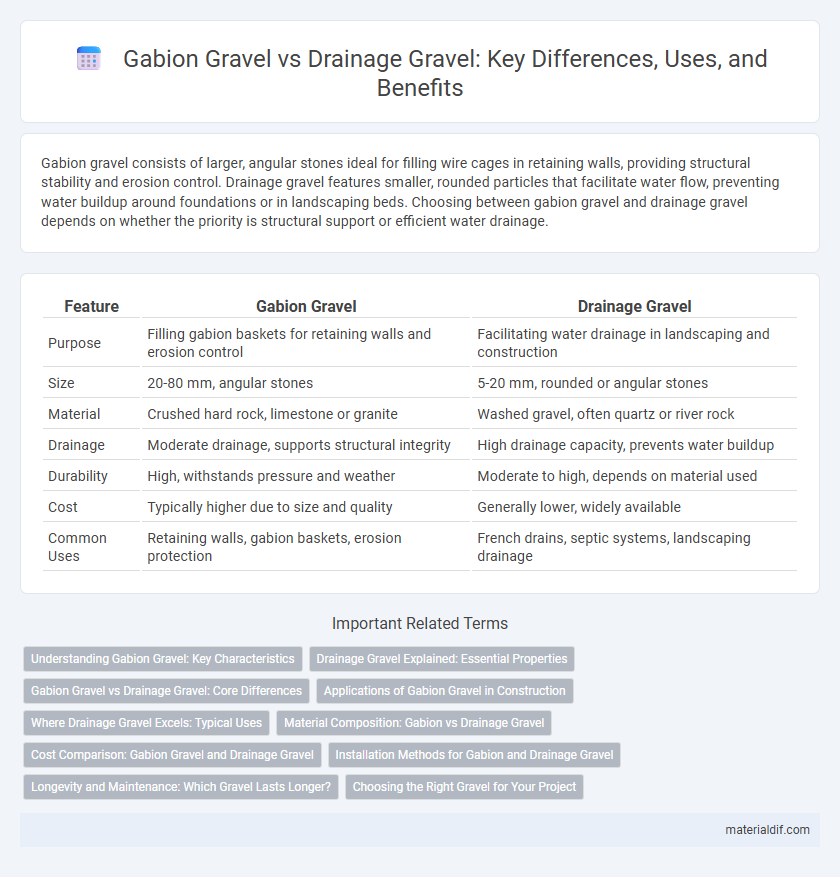Gabion gravel consists of larger, angular stones ideal for filling wire cages in retaining walls, providing structural stability and erosion control. Drainage gravel features smaller, rounded particles that facilitate water flow, preventing water buildup around foundations or in landscaping beds. Choosing between gabion gravel and drainage gravel depends on whether the priority is structural support or efficient water drainage.
Table of Comparison
| Feature | Gabion Gravel | Drainage Gravel |
|---|---|---|
| Purpose | Filling gabion baskets for retaining walls and erosion control | Facilitating water drainage in landscaping and construction |
| Size | 20-80 mm, angular stones | 5-20 mm, rounded or angular stones |
| Material | Crushed hard rock, limestone or granite | Washed gravel, often quartz or river rock |
| Drainage | Moderate drainage, supports structural integrity | High drainage capacity, prevents water buildup |
| Durability | High, withstands pressure and weather | Moderate to high, depends on material used |
| Cost | Typically higher due to size and quality | Generally lower, widely available |
| Common Uses | Retaining walls, gabion baskets, erosion protection | French drains, septic systems, landscaping drainage |
Understanding Gabion Gravel: Key Characteristics
Gabion gravel consists of angular, crushed stones that provide excellent interlocking capabilities, making it ideal for use in gabion baskets for retaining walls and erosion control. This type of gravel offers superior stability and drainage due to its irregular shapes, which create voids for water passage while preventing soil displacement. Unlike drainage gravel, which is typically rounded and used primarily for water flow management, gabion gravel is engineered to ensure structural strength and durability in construction applications.
Drainage Gravel Explained: Essential Properties
Drainage gravel is characterized by its angular shape and uniform size, allowing efficient water flow and preventing clogging in drainage systems. Its high permeability and durability make it ideal for use in French drains, septic systems, and retaining wall backfills. Unlike gabion gravel, which is often larger and irregularly shaped to fill wire cages, drainage gravel optimizes water movement and soil stability in construction and landscaping projects.
Gabion Gravel vs Drainage Gravel: Core Differences
Gabion gravel consists of larger, angular stones designed to fit securely within wire mesh cages, providing structural support and erosion control in landscaping and construction. Drainage gravel typically features smaller, rounded stones that facilitate efficient water flow and prevent soil clogging in drainage systems. The core difference lies in gabion gravel's role in stability and containment versus drainage gravel's primary function in enhancing water permeability and drainage efficiency.
Applications of Gabion Gravel in Construction
Gabion gravel is primarily used in construction for erosion control, retaining walls, and slope stabilization due to its coarse, angular texture that allows excellent drainage and structural integrity within wire mesh cages. Its applications include reinforcing embankments, riverbank protection, and landscaping projects where durability and permeability are critical for longevity. Unlike drainage gravel, which is designed mainly to facilitate water flow in drainage systems, gabion gravel serves both as a functional and aesthetic material in civil engineering and architectural designs.
Where Drainage Gravel Excels: Typical Uses
Drainage gravel excels in applications requiring efficient water flow and soil stabilization, such as French drains, septic drain fields, and retaining wall backfill. Its angular shape and size distribution facilitate superior permeability and prevent clogging, making it ideal for managing stormwater and reducing erosion. Commonly composed of crushed stone, drainage gravel is preferred in landscaping and construction projects where effective drainage is critical.
Material Composition: Gabion vs Drainage Gravel
Gabion gravel consists mainly of large, angular stones such as granite or basalt, designed for durability and stability when used in wire mesh cages for retaining walls. Drainage gravel typically comprises smaller, rounded stones like limestone or river rock, facilitating efficient water flow and preventing soil erosion in drainage systems. The difference in material composition directly impacts their respective structural and hydrological functions in construction and landscaping projects.
Cost Comparison: Gabion Gravel and Drainage Gravel
Gabion gravel typically costs more than drainage gravel due to its larger, uniform stone size designed for structural support in gabion baskets. Drainage gravel is generally less expensive because it consists of smaller, angular stones optimized for water flow and filtration. The price difference reflects the distinct functional properties and sourcing requirements of each gravel type.
Installation Methods for Gabion and Drainage Gravel
Gabion gravel installation involves filling wire mesh cages with angular stones and securely stacking them to form a stable retaining structure, ensuring proper compaction and alignment for durability. Drainage gravel installation requires spreading uniformly graded, rounded gravel layers to facilitate water flow, typically placed over a geotextile fabric to prevent soil migration and maintain efficient drainage. Both methods prioritize site preparation and proper layering but differ significantly in structural containment and hydraulic functionality.
Longevity and Maintenance: Which Gravel Lasts Longer?
Gabion gravel is known for its exceptional durability as it is encased within steel wire baskets, providing structural stability and protection against erosion, which significantly extends its longevity. Drainage gravel, while effective at promoting water flow and preventing pooling, tends to require more frequent maintenance to remove debris and prevent clogging that can reduce its lifespan. The protective containment of gabion gravel generally leads to lower maintenance needs and a longer-lasting installation compared to drainage gravel.
Choosing the Right Gravel for Your Project
Gabion gravel consists of angular, crushed stones typically sized between 2 to 4 inches, ideal for filling wire mesh cages used in retaining walls and erosion control projects due to its stability and durability. Drainage gravel, composed of smaller, rounded stones around 0.5 to 1 inch, facilitates water flow in applications such as French drains, septic systems, and landscape drainage by preventing water accumulation. Selecting the appropriate gravel depends on project requirements: gabion gravel provides structural support and erosion resistance, while drainage gravel ensures proper water movement and prevents soil clogging.
Gabion Gravel vs Drainage Gravel Infographic

 materialdif.com
materialdif.com